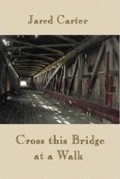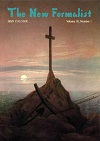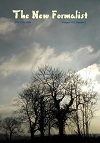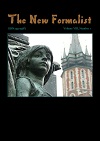David Lee Garrison: All your previous books reveal an interest in form and an increasing use of rhyme, but I must say I was surprised to find nothing but villanelles in Les Barricades Mystérieuses. What led you to choose this particular form? Do you find some special forcefulness or freedom in it?
Jared Carter: I wanted to put together an extended group of poems. I had published a narrative of seven stanzas about a visit to Emily Dickinson’s house. Each stanza has fourteen lines and the end rhymes are those of an Italian sonnet.
In After the Rain there’s a poem consisting of seven unrhymed fourteen-line stanzas in which key words in the last line of each stanza are repeated in the first line of the following stanza. There’s also a poem consisting of three stanzas, each of which is a triolet. As you know, a triolet repeats entire lines. So I had been tinkering with sonnet-like stanzas and with the repetition of entire lines.
DLG: But from the beginning, you were decided against doing a sonnet sequence?
JC: It's been done so many times before. And often to great effect. I knew and admired a great many sonnet sequences, from the Elizabethans to Millay and Rilke. But I hadn't noticed any sequences of villanelles, at least in English. And I wanted to work in a form in which entire lines are repeated.
When it was finished what we seemed to have was more a progression of villanelles than a sequence. There’s an implied narrative, but there’s also movement within the poems based on association. By the time the book came out, I had realized that the best possible word to describe it was configuration – a configuration of villanelles.
DLG: I like the French title. Could you elaborate a bit on its significance and why you chose to put it in French? Why not "The Mysterious Barricades"?
JC: I left it in French to emphasize the connection with Couperin and his “Barricades Mystérieuses,” as explained in the notes. But beyond that, the French provides a link to the historic landscape of the poems. Most of them are set in or near a large nineteenth-century house located somewhere in the rural Midwest. If you go back far enough, to the late seventeenth and early eighteenth centuries, the Midwest – the Old Northwest – has what might be called a “French connection.” Even at the time of the American Revolution, much of the area between Detroit and what eventually became New Orleans was a sphere of French influence. Traces of those antecedents remain in the form of place names, buildings, and folkways.
Growing up in the Midwest, I’ve always been aware of this heritage. When I was much younger, in the 60s, I had the good fortune to live near Paris for a couple of years. More recently, here in the Midwest, I’ve spent some time seeking out French influences in places like New Orleans, St. Louis, Vincennes, and Ste. Genevieve. So the French title of this book was intended as homage to that tradition. And of course the villanelle is a French form.
DLG: To take up the issue of form again, I notice that all the titles have only one word and that the book is divided into four sections of eight poems, and I am sure there are other symmetries I have not seen. Were you trying to satisfy some inner “rage for order” as you wrote the book? Or are there other reasons for these symmetries?
JC: At some point I must have noticed that there were a number of single-word titles, and decided that I might as well do that for all of the poems. For certain readers the villanelle can be a daunting form, and I thought a simple, easy-to-grasp title might help to make this or that poem more accessible.
Arranging poems in sections has always seemed useful to me, just as chapters are helpful in a novel or scenes and acts in a play. They give the reader a chance to pause and reflect. As for the four sections of eight poems, well, Barricades started out as a chapbook. It grew, thanks to the patience and generosity of the editor, Leonard Trawick, and his colleagues at the Poetry Center. But we all knew that it couldn’t grow beyond a certain point.
DLG: How did you go about determining that point?
JC: I think we were searching for a kind of critical mass of villanelles. We knew we couldn’t overdo it and include fifty or a hundred villanelles. It’s not the kind of poem the average reader encounters every day. If the experience of reading a number of such poems is to be pleasurable and not off-putting, what is the right number?
Two dozen seemed too few; that didn’t allow enough of the landscape and the atmosphere to come across. And three dozen seemed too many. We wanted the reader to forget all about the form, and instead be drawn into the world the poems were presenting. But there is clearly a limit to the concentration you can ask from a reader.
DLG: It sounds like you had the reader and the reader’s experience of your work in mind more than any “rage for order.” Is that right?
JC: Order is important, surely, but so is proper length. Call it proportion. I don’t know about you, but I get a bit bored when I’m halfway through Shakespeare’s sonnets. My attention starts to wander, too, when I’m into the second section of the Sonnets to Orpheus. I think Millay’s fifty-two sonnets are just about right for the kind of sonnet she includes, which is personal and addressed to a particular individual. I like George Meredith’s sequence of fifty, too, called Modern Love. Rossetti’s House of Life, with its hundred and one sonnets, is more intimidating. Elizabeth Browning gives us forty-four sonnets, which is a far more manageable number. You can read them in a single sitting and not feel fatigued.
But those are sonnets, and the sonnet is most often a discursive poem, one which can wander far afield from its lyric origins. This in turn enables the author to cover a variety of subjects and themes, as in Shakespeare, Sidney, or Daniel. If you intersperse the discursive with the lyric, you can not only present and sing, you can also talk about. In this way you can get greater mileage out of the basic form.
DLG: I’ve never thought of the sonnet as being a discursive form since it is so short. I would think the villanelle would give you a bit more space in which to play. What do you mean, exactly, by “discursive”?
JC: At least in English the sonnet tends to be a brief form for considering something. For mulling it over. There are eight lines of statement followed by six lines of qualification or resolution. Basically, it’s a kind of call and response. As long as you take care of the end rhymes and keep the iambic beat going, you can talk about virtually anything at all in a sonnet. But the form doesn’t sing all that much.
The villanelle is much closer to its origins in music and dance, and perhaps for that reason it actually offers less opportunity for saying something than the sonnet does. After the initial tercet you’re stuck with those first and third lines. Each must appear four times in the course of the poem. Subtract eight from nineteen, and that leaves you with only eleven lines in which to say something. That’s three fewer than the sonnet.
DLG: Why attempt to say anything at all? If the strength of the villanelle lies in its music and sound effects, why not concentrate on those elements?
JC: For the same reason that there are few pure lyrics in Shakespeare’s plays. A little lyric goes a long way. He writes lovely songs, but one encounters them surrounded by a great deal of blank verse. If you’re going to write a bunch of villanelles, they can’t all be lyrical. Some of them have got to say something, even though, as I’ve said, it’s hard to write a discursive villanelle.
DLG: Has this always been the case?
JC: Traditionally, again, the tendency – the solution – has been to treat the villanelle as a vehicle for light verse. This is what the English did with the form when they borrowed it from the French in the second half of the nineteenth century. The French hadn’t taken it very seriously, either, though they deserve credit for revivifying it.
The villanelle is the most repetitive of the traditional forms, with the possible exception of the pantoum. There’s the additional restriction that it turn on two rhymes. But the strength of the villanelle, what drives it along – the engine at its heart – is all that repetition. It is a kind of poem which most of all we need to hear, as well as see, in order to get its full effect.
DLG: Couldn’t all that repetition become a problem, become boring?
JC: I don’t think it does, in a single villanelle. But in a series of such poems you can’t go on disguising the repetition for very long – keeping it out of the foreground of the reader’s consciousness. Repetition is a powerful device. As with any poetic device – rhyme and rhythm especially – you must be careful not to overdo it.
Anyway, as Leonard Trawick and I tried different combinations, we finally settled on thirty-two villanelles separated into four sections. We added some artwork, too, and some notes at the end. The entire configuration seemed just about right – like the Mama Bear’s porridge, chair, and bed in the Goldilocks story.
DLG: You say the villanelle needs to be heard. Do you have any special technique for reading this form? I have heard you read twice now, and I have always been impressed that you memorize the poems, even that very long one from After the Rain. Will you now memorize villanelles for your readings?
JC: I have no special method for reading poems aloud, except for the advice I was given many years ago by a mentor, Jim White, a very wonderful man, who said “Speak clearly, and make sure that everyone in the room can hear every word.”
DLG: How do you write a villanelle? Do you start with the two lines that will be repeated and then weave around them? Do you write a complete stanza and then develop lines one and three? Do you write something down that doesn’t rhyme or rhymes haphazardly and then fashion it into a villanelle?
JC: Well, it’s all of the above, and probably a bit more. I couldn’t begin to provide a formula. What really mattered most was practice and persistence. The more villanelles I wrote, the better I seemed to get at writing them. The form itself and its peculiar requirements remained the same. I wouldn’t say it became easier as I went along, but at least I gained confidence.
Some of the villanelles that I wrote later on seemed to fall into place more quickly than some of the earlier ones. And some of the later ones seemed to say more of what I wanted to say than some of the earlier ones. But not invariably. Chance and luck and the weather and the time of day and a thousand other factors had a way of entering into the process at the beginning of the book and also at the end.
DLG: All your work reveals an attitude of awe toward the natural world, especially the capacity of that world to mark the passage of time. The title poem of Work, for the Night Is Coming is perhaps the most notable example of that, but the feeling is pervasive in your poetry. And yet I am not sure how you do it. How do you express that sense of wonder?
JC: Years ago I heard Robert Bly speak, and he said something I’ve always remembered. He said that poetry has to “come up close to its object.” That made a great deal of sense to me – coming up close. I’m a great believer in careful observation, along with extensive background study. There are certain totems I write about repeatedly – mourning doves, crows, hedgeapple trees, cicadas, peonies. After observing them for many years, and reading about them, and talking to other people about them, I have picked up a number of useful concrete details.
DLG: Do you intentionally put such details in your poems?
JC: They don’t show up in every poem, yet the depth is there, and the resonance, which may serve to emphasize or enhance a particular line or image. Also there’s a hint of my own fascination with a particular detail, which sometimes can be esoteric and odd, sometimes commonplace.
A Cecropia moth, for example, or a yellow-shafted flicker, is certainly a creature of wonder, to use your word. I suppose once I’ve become acquainted with marvels of this sort, my enthusiasm and awe impel me to write, in the hope of sharing such emotion with others.
DLG: So your poetry starts, then, with that sense of awe?
JC: I’m not sure I know how poems get started, but isn’t that what we all hope the finished poem will achieve? A sense of wonder or awe? I knew a psychiatrist once who said all good poems deal in magic. They prestidigitate, right before your eyes. You run across a powerful poem in a magazine and you think “Wow, that was really something!” Or, as the young people say, “Awesome!”
DLG: You often write about remnants, remainders, broken pieces of the past. In “Ditchweed,” for example, “the bank owns everything now. From windows / in the old farmhouses, no one glances back …” In such poems the progress of technology often displaces and destroys lives, and life itself is revealed as fragile and temporary in relation to the earth. You seem to be reminding us that the ruins around us point to important things we have lost.
JC: I agree with much of what you’re saying, and yet I’m not certain if “ruins” is the right word. Perhaps it’s broader than that. Maybe we’re referring to the way the past itself can speak to us. Henry James has that wonderful phrase, in his preface to The Aspern Papers, about how he delights “in a palpable imaginable visitable past.” He goes on to say that it is “the past fragrant of all . . . the poetry of the thing outlived and lost and gone.” And yet somehow the artist can make it “appreciable.”
In certain instances, yes, as you’ve pointed out, there seem to be nothing left except “ruins.” But when one thinks of the past as represented by, say, the Shakers, then such a past seems to be with us still, and to be vibrant and important in its own right. And worth celebrating, even now. If it can warn us about the effects of technology and materialism in our own lives, so much the better.



